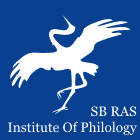 |
|
||||||||||||
|
Institute of Philology of
the Siberian Branch of Russian Academy of Sciences |
|
||||||||||||
|
|||||||||||||
| Sibirskii Filologicheskii Zhurnal (Siberian Journal of Philology) | |
|
Article
Authors: E. G. Baranova Nizhny Novgorod State Linguistic University, Nizhny Novgorod, Russian Federation In the section Study of literature
Abstract: The paper addresses “The Consolations of the Forest” by S. Tesson, where the author creates a new myth of Siberia. The documentary image of Siberia in the novel is full of sophisticated mythopoetic symbolism. Siberian locus is semanticized both as a chthonian land and a land of purity. Purity, the main semantic characteristic of the Siberian chronotope, is associated with silence, emptiness, simplicity, naturalness, and cold. Motifs of simplicity and naturalness connect the concept of purity with the idea of the beautiful. Tesson reveals the meanings that make Siberia a part of cultural space. The purity complex is closely connected with the existential notion of freedom. The novel is organized by the idea of the narrator’s initiation, setting him free. The Sibe-rian forest is shown to be an ideal liminal land, leading to the realm of freedom. The liminal char-acter of the Siberian chronotope is manifested in the infernal semantics and the characteristics common to an island and a desert. The plot can be interpreted as a rite of passage in which the narrator, melting into Baikal nature, acquires freedom and peace. Liminality, a basic myth for the Siberian text, is explored in a new way, more akin to the model of the Siberian text that pre-vails in classic Russian novels, where Siberia is represented as a place of temporary death leading to resurrection. Tesson mythologizes the geographic space heeding not to the stereotypes existing in the French culture but to his own beliefs. The Siberian locus incarnates Tesson’s values and represents the sum total of a dream of a contemporary person exhausted with the consumerist society and aspiring personal freedom. Keywords: Siberia, Siberian text, S. Tesson, “The Consolations of the Forest”, liminality, locus Bibliography: Cavill P., Ward H. The Christian Tradition in English Literature: poetry, plays and shorter prose. Mich., Zondervan, 2007, 512 p. Fizaine J.-C. Balzac et l’image de la Russie. In: Balzac dans l’Empire Russe: de la Russie à l’Ukraine. Judith Meyer-Petit et Anne Klimoff. (Éds). Paris, Paris-Musées, Ed des Cendres, 1993, pp. 35–51. Gennep A., van. Obryady perekhoda. Sistematicheskoe izuchenie obryadov [Rites of passage. Systematic studying of rites]. Transl. from French. Moscow, Vost. lit., 1999, 198 p. Kozachenko A. I. Transsibirskaya magistral’ kak simvol kul’turnykh otnosheniy mezhdu Rossiey i Frantsiey: literaturnye puteshestviya v 1893–1913 gg. [Trans-Siberian railway as symbol of relations between Russia and France: literary travels in 1893-1913]. RUDN Journal of Russian History. 2016, no. 3, pp. 90–97. Krauss C. La Russie et les Russes dans la fiction française du 19e siècle. 1812–1917. In: D’une image de l’autre à un univers imaginaire. Amsterdam, Rodopi, 2007, 446 p. Lavrov A. La première description française de la Sibérie. In: L’invention de la Sibérie par les voyageurs et écrivains français (18e – 19e siècles). S. Moussa et A. Stroev (Éds). Paris, Institut d’études slaves, 2014, pp. 15–24. Lotman Yu. M. Syuzhetnoe prostranstvo russkogo romana 19 stoletiya [Plot space of a Russian novel of the 19th century]. In: Lotman Yu. M. O russkoy literature [On Russian literature]. St, Petersburg, Iskusstvo, 1997, pp. 712–729. Mednis N. E. Poetika i semiotika russkoy literatury [Poetics and semiotics of the Russian literature]. Moscow, LRC Publishing House, 2011, 232 p. Neboit-Mombet J. L’image de la Russie dans le roman français, 1859–1900. Clermont-Ferrand, Presses Universitaires Blaise Pascal, 2005, 510 p. Toporov V. N. Peterburg i “Peterburgskiy tekst russkoy literatury” (Vvedenie v temu) [Petersburg and “The St. Petersburg Text of Russian Literature.” (Introduction to the topic)]. In: Toporov V. N. Mif. Ritual. Simvol. Obraz: Issledovaniya v oblasti mifopoeticheskogo: Izbrannoe [Myth. Ritual. Symbol. Image: Mythological studies]. Moscow, Progress – Kul’tura, 1995, pp. 259–367. Toporov V. N. Prostranstvo i tekst [Space and text]. In: Tekst: semantika i struktura [Text: semantics and structure]. Moscow, 1983, pp. 227–284. Turner V. Simvol i Ritual [Symbol and Ritual]. Moscow, Nauka, 1983, 277 p. Tyupa V. I. Mifologema Sibiri: k voprosu o “sibirskom tekste” russkoy literatury [The Mythologeme of Siberia: on the issue of the “Siberian text”]. Siberian Journal of Philology. 2002, no. 1, pp. 27–35. |
 |
Institute of Philology Nikolaeva st., 8, Novosibirsk, 630090, Russian Federation +7-383-330-15-18, ifl@philology.nsc.ru |
© Institute of Philology |


